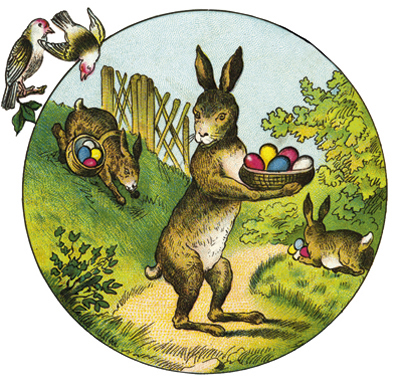Did you ever wonder where the term Easter came from? Or why we celebrate with colored eggs brought by a rabbit? Or How the Ressurection came to be associated with any of the traditions of modern Easter?
Well, get ready to learn all about that stuff.
Before we go down the rabbit hole, I feel compelled to point out a few things. First, this discussion is centered around Anglo Germanic traditions. Easter in French is Les Paques, in spanish it’s Pascua de Resurrección and Pasqua in Italian. All three are rooted in the Latin word ‘pascua’ meaning food which itself comes from the Hebrew word ‘pessah’ meaning passing way (or passage). Second, the early Church in an attempt to wipe out paganism co-opted a lot of pre-christian holidays and traditions.
To find the roots of the word Easter we need to get into the way-back machine and take a trip to pre-christian northern Europe. The germanic peoples there (that includes the Angles, Saxons, Jutes and Frisians who had settled in England by this time) celebrated the spring equinox with a feast for the goddess Eostre or Ostara. Eostre was the goddess of Spring, fertility and the dawn.
The only surviving attestation about Eostre’s feast comes from the Venerable Bede, an 8th century monk. In his work The Reckoning of Time, Bede states that during Ēosturmōnaþ (the equivalent of April), pagan Anglo-Saxons had held feasts in Ēostre’s honour, but that this tradition had died out by his time, replaced by the Christian Paschal month, a celebration of the resurrection of Jesus.
Can we be entirely sure that Easter is linguistically rooted in Eostre/Ostara? Probably not, however it sure looks that way. Without going too far into the weeds, etymologically speaking, the anglo-germanic languages use cognate words for Easter and they all are based on the local dialect version of Eostre/Ostara. The german word for easter, Ostern is closely related to Ostara, the german word for Eostre.
Now that we’ve (kind of) established the origins of the word, let’s take a look at the traditions.
Why a bunny? Well, seeing as Eostre was the goddess of fertility among other things, rabbits were one of her symbolic animals. There’s some truth to the old saw they breed like rabbits, and the pagans thought the rapidly reproducing animal was a good symbol for fecundity. It is notable that you only find the easter bunny tradition in areas that use the word Easter/Ostern to describe the Ressurection. A Parisian would give you the side eye if you asked where you could find an easter bunny in Paris.
Oddly enough, it’s the same thing with eggs, although they weren’t connected to Eostre. Many pre-christian societies celebrated spring with colored eggs. They were also considered a symbol of fertility by most ancient societies.
